《会计学原理》考试复习练习(1-4章)
会计学原理练习题及参考答案(全五套)
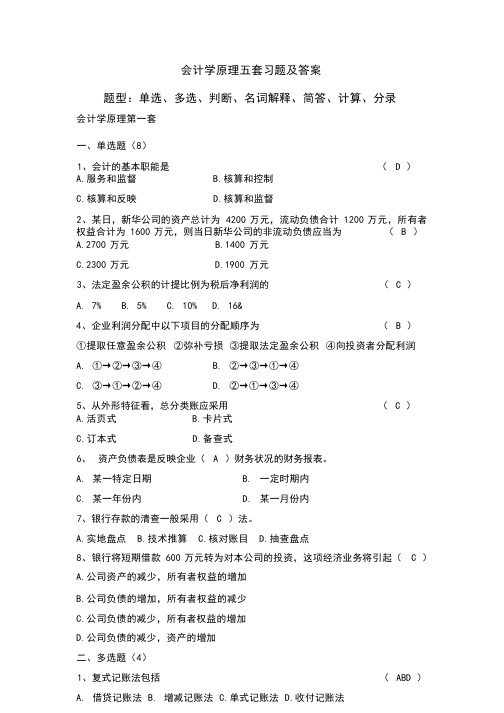
会计学原理五套习题及答案题型:单选、多选、判断、名词解释、简答、计算、分录会计学原理第一套一、单选题(8)1、会计的基本职能是( D )A.服务和监督B.核算和控制C.核算和反映D.核算和监督2、某日,新华公司的资产总计为 4200 万元,流动负债合计 1200 万元,所有者权益合计为 1600 万元,则当日新华公司的非流动负债应当为( B )A.2700 万元 B.1400 万元C.2300 万元D.1900 万元3、法定盈余公积的计提比例为税后净利润的( C )A. 7%B. 5%C. 10%D. 16&4、企业利润分配中以下项目的分配顺序为( B )①提取任意盈余公积②弥补亏损③提取法定盈余公积④向投资者分配利润A. ①→②→③→④B.②→③→①→④C. ③→①→②→④D.②→①→③→④5、从外形特征看,总分类账应采用( C )A.活页式B.卡片式C.订本式D.备查式6、资产负债表是反映企业( A )财务状况的财务报表。
A. 某一特定日期B. 一定时期内C. 某一年份内D. 某一月份内7、银行存款的清查一般采用( C )法。
A.实地盘点B.技术推算C.核对账目D.抽查盘点8、银行将短期借款 600 万元转为对本公司的投资,这项经济业务将引起( C )A.公司资产的减少,所有者权益的增加B.公司负债的增加,所有者权益的减少C.公司负债的减少,所有者权益的增加D.公司负债的减少,资产的增加二、多选题(4)1、复式记账法包括(ABD )A. 借贷记账法B. 增减记账法C.单式记账法D.收付记账法2、工业企业下列项目记入营业外支出的有(ABCE )A 罚款支出B 固定资产盘亏C 公益性捐赠D 租入固定资产租金E 非常损失3、账簿扉页上的内容包括。
(ABD )A.启用日期B.账簿起止页数C.账户目录D.账簿交接时间4、以下按原始凭证填制手续不同划分的有(ABD )A.累计凭证B.一次原始凭证C. 自制原始凭证D.汇总原始凭证三、判断题(6)1、记账凭证账务处理程序的特点是直接根据记账凭证逐笔登记总分类账,是最基本的账务处理程序。
会计学原理复习题含答案

读书破万卷下笔如有神__________________________________第一章单选题1、会计的管理活动论认为( A )oA、会计是一种经济管理活动B、会计是一个经济信息系统C、会计是一项管理经济的工具D、会计是以提供经济信息,提高经济效益为目的的一种管理活动2、会计的基本职能是(B )oA、控制与监督B、反映与监督C、反映与核算D、反映与分析3、属于会计工作实践生产的结果的是( A )oA、会计作用B、会计任务C、会计目的D、会计对象4、下列不属于会计核算专门方法的是( B )oA、成本计算与复式记账B、错账更正与评估预测C、设置账户与填制、审核会计凭证D、编制报表与登记账簿5、会计方法体系中,其基本环节是( A )oA、会计核算方法B、会计分析方法C、会计监督方法D、会计决策方法6、近代会计史中的两个程碑是(A )oA、帕乔利复式簿记著作的岀版和会计职业的岀现B、生产活动中岀现了剩余产品和会计萌芽阶段的产生C、会计学基础理论的创立和会计理论与方法的逐渐分化D、首次岀现“会计”二字构词连用和设置了“司会”官职7、会计的职能是( D )oA、一成不变的B、随着生产关系的变更而发展C、只有在社会主义制度下才能发展D、随着社会的发展、技术的进步、经济关系的复杂化和管理理论的提高而不断变化8、会计的反映职能不具有(B )oA、连续性B、主观性C、系统性9、会计在反映各单位经济活动时主要使用(A、货币量度和劳动量度C、实物量度和其他量度10、对会计目标主要有两种学术观点(A、决策有用观与受托责任观B、C、信息系统观与管理活动观D、11、会计具有双重属性,即(D )A、社会性与综合性C、系统性与技术性12、应用会计学包括( D )oA、财务会计、管理会计和实证会计D、全面性D )oB、劳动量度和实物量度D、货币量度和实物量度A )o决策有用观与信息系统观管理活动观与决策有用观B、综合性与系统性D、技术性与社会性B、管理会计、实证会计和审计C、实证会计、审计和财务会计D、财务会计、管理会计和审计、多选题.读书破万卷下笔如有神 _________________________________1、下列说法正确的有(ABCDE )。
《会计学原理》随堂练习参考答案
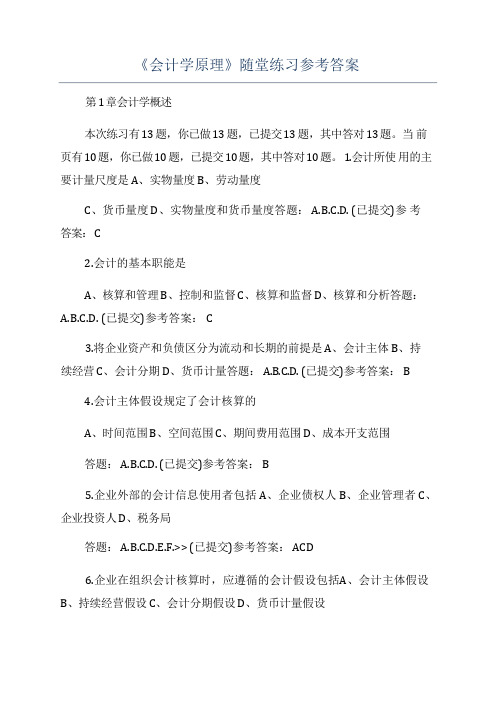
《会计学原理》随堂练习参考答案第 1 章会计学概述本次练习有 13 题,你已做 13 题,已提交 13 题,其中答对 13 题。
当前页有 10 题,你已做 10 题,已提交 10 题,其中答对 10 题。
1.会计所使用的主要计量尺度是 A、实物量度 B、劳动量度C、货币量度D、实物量度和货币量度答题: A.B.C.D. (已提交)参考答案: C2.会计的基本职能是A、核算和管理B、控制和监督C、核算和监督D、核算和分析答题:A.B.C.D. (已提交)参考答案: C3.将企业资产和负债区分为流动和长期的前提是 A、会计主体 B、持续经营 C、会计分期 D、货币计量答题: A.B.C.D. (已提交)参考答案: B4.会计主体假设规定了会计核算的A、时间范围B、空间范围C、期间费用范围D、成本开支范围答题: A.B.C.D. (已提交)参考答案: B5.企业外部的会计信息使用者包括 A、企业债权人 B、企业管理者 C、企业投资人 D、税务局答题: A.B.C.D.E.F.>> (已提交)参考答案: ACD6.企业在组织会计核算时,应遵循的会计假设包括A、会计主体假设B、持续经营假设C、会计分期假设D、货币计量假设答题: A.B.C.D.E.F.>> (已提交)。
参考答案: ABCD7.反映企业经营成果的会计要素有 A、资产 B、收入 C、费用 D、利润 E、所有者权益答题: A.B.C.D.E.F.>> (已提交)参考答案: BCD8.下列各项属于静态会计要素的是 A、资产 B、收入 C、费用 D、负债 E、所有者权益答题: A.B.C.D.E.F.>> (已提交)参考答案: ADE 9.会计要素中既有反映财务状况的要素,也有反映经营成果的要素。
答题:对.错.(已提交)参考答案:√10.一项经济业务的发生引起负债的增加和所有者权益的减少,会计基本等式的平衡关系不受其影响。
《会计学原理》练习题

第一章总论、单项选择题1、会计从本质上说是一种( C )。
A、信息系统B、工作方法C、管理活动D、计算工具2、在商品经济条件下,会计的对象是社会再生产过程中的()A、资金运动B、物资流通C、经济业务D、经济活动3、会计的任务是由()的客观要求所决定的。
A、企业领导B、经济管理C、上级部门D、国家4、会计核算的基本前提中,为会计工作规定了活动空间范围的是()。
A、会计主体B、继续经营C、会计分期D、货币计量5、保证不同会计主体之间会计指标口径一致的会计核算一般原则是()。
A、一致性原则B、可比性原则C、真实性原则D、相关性原则6、《企业会计准则》规定,企业应采用()为记账的基础。
A、收付实现制B、现金制C、权责发生制D、历史成本7、()是对会计内容进行分类核算和监督的一种专门方法。
A、复式记账B、登记账簿C、财产清查D、设置账户8、()是记录经济业务、明确经济责任,作为记账依据的书面证明A 、会计账户B 、会计账簿C 、会计凭证D 、会计报表二、多项选择题1、 会计的基本职能是(AE )。
A 、核算B 、控制C 、预测 2、 工业企业的生产经营活动,分为(3、下列属于会计核算方法的有( )4、会计核算的基本前提包括( )。
A 、会计主体B 、历史成本C 、会计分期 E 、货币计量5、 会计核算的一般原则中,属于总体性要求的原则包括( )。
A 、真实性原则B 、可比性原则C 、及时性原则D 、一致性原则E 、谨慎性原则6、 会计核算的一般原则中,( )属于对会计要素确认、计量要求的原则A 、 权责发生制原则B 、 配比原则C 、 划分收益性支出与资本性支出原则D 、 重要性原则E 、实际成本原则D 、决策E 、监督)等过程。
A 、供应B 、生产C 、流能D 、销售E 、消费A 、填制凭证B 、编制报表C 、登记账簿D 、单式记账D 、继续经营7、配比原则要求将企业的收入与其相关的()相互配比A、利润B、成本C、费用D、资产E、负债二、判断题1、会计的对象总的来说是社会再生产过程中的经济活动。
《会计学原理》考试试题4及答案

会计学基础练习题一一、单项选择题1.会计所使用的主要计量尺度是()。
A.实物量度B.劳动量度C.货币量度D.实物量度和货币量度2.会计的基本职能是()。
A.核算和管理B.控制和监督C.核算和监督D.核算和分析3.会计的一般对象可以概括为()。
A.经济活动B.再生产过程中的资金运动C.生产活动D.管理活动4.下列业务不属于会计核算范围的事项是()。
A. 用银行存款购买材料B. 生产产品领用材料C. 企业自制材料入库D. 与外企业签定购料合同5.会计主体假设规定了会计核算的()。
A.时间范围B.空间范围C.期间费用范围D.成本开支范围6.下列属于收益性支出的有()。
A.建造房屋的各项支出B.长期股票投资支出C.生产工人工资D.为取得专利权发生的支出7.下列各项中适用于划分各会计期间收入和费用的原则是()。
A.实际成本计价原则B.一致性原则C.权责发生制原则D.谨慎性原则8.下列各项中适用于财产计价的原则是()。
A.权责发生制原则B.配比原则C.收付实现制原则D.实际成本原则9.下列原则中不属于信息质量要求的原则是()。
A.明晰性原则B.可比性原则C.配比原则D.相关性原则10.2001年9月20日采用赊销方式销售产品50 000元,12月25日收到货款存入银行。
按收付实现制核算时,该项收入应属于()。
A. 2001年9月B. 2001年10月C. 2001年11月D. 2001年12月11.2002年3月20日采用赊销方式销售产品60 000元,6月20日收到货款存入银行。
按权责发生制核算时,该项收入应属于()。
A. 2002年3月B. 2002年4月C. 2002年5月D. 2002年6月12.某企业2002年7月支付厂部管理人员工资12 000元,预支厂部半年(含本月)修理费1800元.生产车间保险费4000元。
按权责发生制核算时,该企业2001年7月管理费用发生额为()。
A. 12 000元B. 13 800元C. 16 300元D. 12 300元13.固定资产采用加速折旧法,主要是体现会计原则中的()。
会计学原理复习题库与部分答案
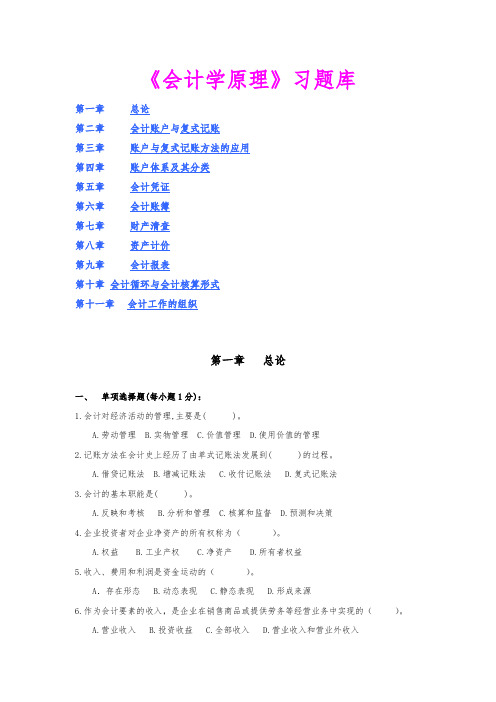
《会计学原理》习题库第一章总论第二章会计账户与复式记账第三章账户与复式记账方法的应用第四章账户体系及其分类第五章会计凭证第六章会计账簿第七章财产清查第八章资产计价第九章会计报表第十章会计循环与会计核算形式第十一章会计工作的组织第一章总论一、单项选择题(每小题1分):1.会计对经济活动的管理,主要是( )。
A.劳动管理B.实物管理C.价值管理D.使用价值的管理2.记账方法在会计史上经历了由单式记账法发展到( )的过程。
A.借贷记账法B.增减记账法C.收付记账法D.复式记账法3.会计的基本职能是( )。
A.反映和考核B.分析和管理C.核算和监督D.预测和决策4.企业投资者对企业净资产的所有权称为()。
A.权益B.工业产权C.净资产D.所有者权益5.收入、费用和利润是资金运动的()。
A.存在形态 B.动态表现 C.静态表现 D.形成来源6.作为会计要素的收入,是企业在销售商品或提供劳务等经营业务中实现的()。
A.营业收入B.投资收益C.全部收入D.营业收入和营业外收入7.()是会计核算和监督的容。
A.会计本质B.会计对象C.会计职能D.会计方法8.会计是以()作为主要计量单位。
A.实物B.劳动C.货币D.实物和货币9.()是指与产品生产无直接关系,属于经营管理过程中发生的,不计入产品成本,而直接计入当期损益的费用。
A.制造成本B.制造费用C.费用D.期间费用10.会计的产生是由于()。
A.生产管理的需要B.社会分工的需要C.生产关系变革的需要D.技术进步的需要11.资产、负债和所有者权益是资金运动的()。
A.存在形态 B.动态表现 C.静态表现 D.形成来源12.我国制订会计准则的主要法律依据是( )。
A.宪法B.国际法C.会计法D.民法13.新《会计法》实施的时间是( )。
A. 2000年7月1日B. 2000年1月1日C. 1999年12月31日D. 2001年1月1日14.企业计提坏账准备是根据( )。
[财务_会计知识]会计学原理习题集答案
![[财务_会计知识]会计学原理习题集答案](https://img.taocdn.com/s3/m/7437d0b2856a561252d36f6e.png)
会计学原理习题集答案第一章总论练习题一、名词:(略)二、单项选择题三、多项选择题四、判断题五、计算题1.【解】(1)按权责发生制本月利润=收入-费用=(5000+6000)-(300+600)=10100(2)按收付实现制本月利润=收入-费用=(20000+10000+5000)-(2500+900)=316002.【解】计算该律师事务所2006年的营业收入=6000000+(140000-97000)+(42000-21000)=6064000(元)3.根据资料,判断每一项目分别属于会计要素的那一项内容,并填入下表。
4.【解】(1)A=375000-(1000+27000+35000+52000+200000)=60000;C=375000;B=375000-(10000+32000+9000+240000+23000)=61000 (2)该企业的流动资产总额=1000+27000+35000+52000=115000(3)该企业的流动负债总额=10000+32000+9000=51000(4)该企业的净资产总额=C-51000-B=375000-51000-61000=263000第二章会计核算基础练习题一、名词:(略)二、单项选择题:三、多项选择题:四、判断题五、业务题【解】1.以上业务的会计分录如下:(1)借:银行存款200000贷:实收资本200000(2)借:固定资产40000贷:银行存款40000(3)借:原材料15000贷:应付账款15000(4)借:库存现金2000贷:银行存款2000(5)借:银行存款20000贷:短期借款20000(6)借:生产成本12000贷:原材料12000(7)借:短期借款30000贷:银行存款30000第三章会计循环练习题一、名词:(略)二、简答:(略)三、单项选择题四、多项选择题五、判断题五、填制记账凭证:(略)六、平行登记练习2.根据经济业务,应作如下会计分录:(1)借:应付账款——乙公司15000贷:银行存款15000(2)借:在途物资——B材料10000应交税费——应交增值税(进项税额)1700 贷:应付账款——甲公司11700(3)借:原材料——B材料10000贷:在途物资——B材料10000(4)借:在途物资——A材料8000应交税费——应交增值税(进项税额)1360 贷:应付账款——丙公司9360(4)借:原材料——A材料8000贷:在途物资——A材料8000(5)借:生产成本12000管理费用3000贷:原材料——A材料15000(6)借:在途物资——B材料10000应交税费——应交增值税(进项税额)1700 贷:应付账款——丙公司11700(7)借:原材料——B材料10000贷:在途物资——B材料10000(8)借:在途物资——A材料5000应交税费——应交增值税(进项税额)850贷:应付账款——乙公司5850(8)借:原材料——A材料5000贷:在途物资——A材料5000(9)借:生产成本19000管理费用2000贷:原材料——B材料21000(10)借:应付账款——甲公司6000贷:银行存款60003.根据上述资料登记入账后,各有关的总分类账和明细分类账见表6-17~表6-26所示。
会计学原理复习题(含参考答案)

会计学原理复习题(含参考答案)一、单选题(共39题,每题1分,共39分)1.下列关于库存现金在盘点后应编制的原始凭证的各项中,正确的是( )。
A、银行对账单B、库存现金盘点报告表C、实存账存对比表D、银行存款余额调节表正确答案:B2.关于会计凭证的保管,下列说法不正确的是( )。
A、会计凭证应定期装订成册,防止散失B、会计主管人员和保管人员应在封面上签章C、原始凭证不得外借,其他单位如有特殊原因确实需要使用时,经本单位会计机构负责人(会计主管人员)批准,可以复制D、经单位领导批准,会计凭证在保管期满前可以销毁正确答案:D3.下面关于账页格式的选择,表述错误的是( )。
A、原材料、库存商品等存货明细账一般采用数量金额式B、收入、成本、费用明细账一般采用三栏式C、库存现金日记账的格式主要有三栏式和多栏式D、总分类账以及资本、债权、债务明细账一般采用三栏式正确答案:B4.下列能在“固定资产”账户核算的有()。
A、经营性租入的设备B、购入正在安装的设备C、购入的不需安装的设备D、融资租入的正在安装的设备正确答案:C5.在借贷记账法下,一般有借方余额的账户是( )。
A、成本类账户B、损益类账户C、费用类账户D、负债类账户正确答案:A6.在借贷记账法下,“投资收益”的增加额登记在( )。
A、贷方B、借方C、借方和贷方D、借方或贷方正确答案:A7.对总分类账格式和登记方法的错误要求是( )。
A、总分类账一般不采用订本账B、总分类账的账页格式有三栏式和多栏式两种C、总分类账的登记方法取决于单位、企业采用的账务处理程序D、总分类账应该按照总分类账户分类登记正确答案:A8.资产、负债、所有者权益三要素是企业资金运动的()。
A、静态表现B、动态表现C、综合表现D、ABC均正确正确答案:A9.()是指生产经营过程中发生的产品生产费用,按各种不同的成本计算对象进行归集和分配,进而计算产品的总成本和单位成本的一种专门方法。
会计学原理复习题
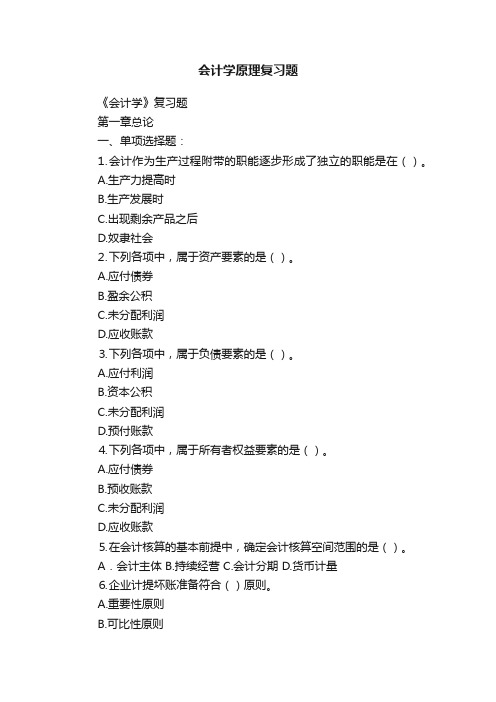
会计学原理复习题《会计学》复习题第一章总论一、单项选择题:⒈会计作为生产过程附带的职能逐步形成了独立的职能是在()。
A.生产力提高时B.生产发展时C.出现剩余产品之后D.奴隶社会⒉下列各项中,属于资产要素的是()。
A.应付债券B.盈余公积C.未分配利润D.应收账款⒊下列各项中,属于负债要素的是()。
A.应付利润B.资本公积C.未分配利润D.预付账款⒋下列各项中,属于所有者权益要素的是()。
A.应付债券B.预收账款C.未分配利润D.应收账款⒌在会计核算的基本前提中,确定会计核算空间范围的是()。
A.会计主体 B.持续经营 C.会计分期 D.货币计量⒍企业计提坏账准备符合()原则。
A.重要性原则B.可比性原则C.谨慎性原则D.配比性原则⒎企业发生的下列支出中,属于收益性支出的是()。
A.购建固定资产支出B.固定资产修理费C.在建工程支出D.无形资产支出⒏下列支出中,体现谨慎性原则要求的是()。
A.无形资产摊销B.当期收入与收益性支出进行配比C.存货按历史成本计价D.应收账款计提坏账准备⒐企业设置“待摊费用”和“预提费用”账户的根据是()。
A.一贯性原则B.权责发生制原则C.可比性原则D.重要性原则⒑我国会计准则规定,企业会计核算应当以()为基础。
A.权责发生制B.永续盘存制C.收付实现制D. 实地盘存制二、多项选择题:⒈下列各项中属于财务状况的会计对象要素有()。
A.本年利润B.制造费用C.待摊费用D.预提费用⒉下列各项,属于资产特征的有()。
A. 形成资产的交易已发生B. 必须是企业拥有或控制的资源C. 必须以实物形式存在D. 能够给企业带来经济利益⒊下列各项中,反映经营成果的会计对象要素有()。
A.收入B.制造费用C.管理费用D.财务费用⒋下列账户中,按照权责发生制原则要求设置的账户有()。
A.财务费用B.待摊费用C.预提费用D.制造费用⒌下列各项支出中,属于资本性支出的有()。
A. 购置固定资产而支付的增值税B. 购入某项专利的支出C. 支付给工程建设项目人员的工资D. 支付固定资产日常维修费三、判断题:⒈会计核算只能用货币作为计量单位。
《会计学原理》各章节习题及综合模拟题

会计学原理习题《会计学原理》重点建设课程项目组2010年9月《会计学原理》是我校会计学专业的专业基础必修课。
该课程主要阐述会计基本理论、基本方法和基本操作技术等内容。
学习《会计学原理》课程,旨在使学生了解会计是企业经济管理的重要组成部分,牢固掌握会计核算和监督的基本理论和方法,从而为财务会计、管理会计等相关专业课程的学习奠定坚实的基础。
为帮助初学者掌握好“三基”,我们编写的《会计学原理习题》,它集各章学习目的与要求、重点与难点、练习与案例于一体,注意体现了内容新、题型活的特点,有助于学生技能的培养和理解能力的提高。
该习题集与现用《会计学原理》教材有机配套,适合我校会计学专业本科阶段学生及其他同等程度的学生练习使用。
由于编写时间仓促,加之准则、制度的飞速革新,在内容上难免存在缺点和错误,我们诚恳欢迎读者批评指正,并将不断完善。
《会计学原理》项目组2010年9月一、单项选择题。
1. ( )是指会计核算和监督的内容。
A.会计职能 B.会计本质 C.会计对象 D.会计方法2.会计的基本职能是()。
A.会计分析 B.会计核算和监督 C.会计预测 D.会计控制3.确定会计核算空间范围的是()。
A.会计主体假设B.持续经营假设C.会计期间假设D.货币计量假设4.确定会计核算时间范围的是()。
A.会计主体假设B.持续经营假设C.会计期间假设D.货币计量假设5.某公司按照每年的经营情况,不断变换存货的计价方法,这种做法违背了()的会计信息质量要求。
A.客观性B.可比性C.及时性D.实质重于形式二、多项选择题。
1.下列有关会计的说法,正确的有()。
A.会计以货币作为主要计量单位。
B.会计以合法的原始凭证作为核算依据。
C.会计的基本职能是核算和监督。
D.会计是一种经济管理活动。
2.会计的监督应包括( )。
A.事前监督 B.事中监督 C.事后监督 D.领导监督3.下列各项中属于会计核算的有( )。
A.会计分析 B.成本计算 C.财产清查 D.复式记账4.按照权责发生制的要求,下列收入或费用应归属于本期的是()A.本期销售产品的收入款项,对方尚未付款B.预付明年的保险费C.本月收回上月销售产品的货款D.尚未实际支付的本月借款利息5.按照收付实现制的要求,下列收入或费用应归属于本期的是()A.本期销售产品的收入款项,对方尚未付款B.预付明年的保险费C.本月收回上月销售产品的货款D.尚未实际支付的本月借款利息三、判断题。
会计学原理课程习题集

习题会计学原理》习题第一章思考题1.影响会计的环境因素有哪些? 2.标志着近代会计发展的重要里程碑是什么?3.从会计产生与发展史中,你可以得出什么结论? 4.会计有那些特点? 5.试述会计对象的内容。
6.何谓会计职能?试述其作用。
7.会计有那几大假设?简述其主要内容。
8.如何理解会计目标? 9.会计核算的基本程序有那些? 10.会计的基本要素有那些?它们之间的关系怎样? 11.什么是会计的基本方法,试述它们之间的关系?第二章思考与练习题一、思考题1.什么是会计要素?其内容是什么?2.负债与所有者权益有什么区别和联系?3.为什么任何经济业务的发生都不会破坏会计恒等式的平衡关系? 4.什么是会计科目?设置会计科目应遵循哪些原则? 5.会计科目分为哪几类?其内容是什么?6.什么是账户?账户与会计科目有什么区别与联系? 7.试说明账户的基本结构及一个完整的账户结构应包括的内容。
8.什么是复式记账法?它有什么特点?9.什么是借贷记账法?包括哪些基本内容?10.试说明借贷记账法下记账符号和账户结构。
11.什么是会计分录和账户对应关系?12.什么是借贷记账法的试算平衡?有哪几种编制方法?、业务题1.练习会计要素的划分资料:某企业月末各项目资料如下:(1)企业库存现金 2 000 元。
(2)存入银行的款项 50 000 元。
(3)向银行借入的 1 年期借款 30 000 元。
(4)应付的购货款 25 000 元。
(5)应收取的销货款 45 000 元。
(6)库存材料 40 000 元。
(7)正在加工中的在产品 60 000 元。
(8)应付给职工的工资 50 000 元。
(9)仓库里存放的库存商品 70 000 元。
(10)向银行借入 5 年期的借款 200 000 元。
(11)房屋建筑物 1 000 000 元。
(12)机器设备 400 000 元。
(13)所有者投入资本 2 212 000 元。
(14)以前年度尚未分配的利润 120 000 元。
《会计学原理》习题答案
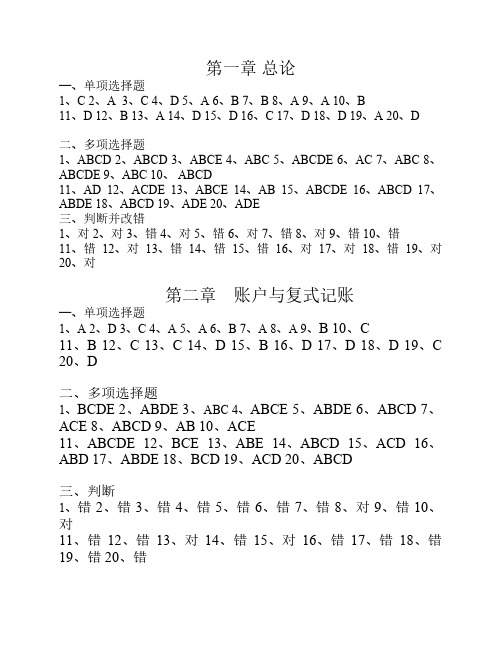
—、单项选择题 1、C 2、A 3、C 4、D 5、A 6、B 7、B 8、A 9、A 10、B 11、D 12、B 13、A 14、D 15、D 16、C 17、D 18、D 19、A 20、D
二、多项选择题 1、ABCD 2、ABCD 3、ABCE 4、ABC 5、ABCDE 6、AC 7、ABC 8、 ABCDE 9、ABC 10、 ABCD 11、AD 12、ACDE 13、ABCE 14、AB 15、ABCDE 16、ABCD 17、 ABDE 18、ABCD 19、ADE 20、ADE 三、判断并改错 1、对 2、对 3、错 4、对 5、错 6、对 7、错 8、对 9、错 10、错 11、错 12、对 13、错 14、错 15、错 16、对 17、对 18、错 19、对 20、对
(四)参考答案:年初与年末利润的差异额=(75000-250000)(600000-200000)=100000元(1)100,000元 (2)100000-40000=60,000元 (3)100000+30000=130,000元 (4)100000+25000-45000=80,000元
(五)业务题资料:
制造费用分配率=27000/60000(A、B产品工人工资总额) =0.45(元)
A产品应摊销制造费用=40000 × 0.45=18000元 B产品应摊销制造费用=20000 × 0.45=9000元 A产品本月发生的生产费用=20 000+ 40 000+ 18 000=78000元 B产品本月发生的生产费用=16 000+ 20 000+9000=45000元 (三)、 A产品本月入库总成本 =15000(10000+3000+2000)+85000(56000+24000+5000)-0=100 000 元 单位入库成本=100 000/2 000=50元/件 单位产品的材料成本= (10 000+56 000)/2 000=33元/件 单位产品的人工成本= (3 000+24 000)/2 000=13.5元/件 单位产品的制造费用= (2 000+5 000)/2 000=3.5元/件
会计学原理第一章练习题

会计学原理第一章练习题练习题:(一)单项选择题1.会计的管理活动论认为()。
A.会计是一种经济管理活动B.会计是一个经济信息系统C.会计是一项管理经济的工具D.会计是以提供经济信息,提高经济效益为目的的一种管理活动。
2.会计的基本职能是()。
A.控制与监督 B.反映与监督C.反映与核算 D.反映与分析3.下列不属于会计核算专门方法的是()。
A.成本计算与复式记账 B.错账更正与评估预测C.设置账户与填制、审核会计凭证 D.编制报表与登记账簿4.会计的职能是()。
A.一成不变的B.随着生产关系的变更而发展C.只有在社会主义制度下才能发展D.随着社会的发展、技术的进步、经济关系的复杂化和管理理论的提高而不断变化5.会计的反映职能不具有()。
A.连续性 B.主观性 C.系统性 D.全面性6.会计目标主要有两种学术观点()。
A.决策有用观与受托责任观 B.决策有用观与信息系统观C.信息系统观与管理活动观 D.管理活动观与决策有用观7.确定会计核算工作空间范围的前提条件是()。
A.会计主体 B.持续经营C.会计分期 D.货币计量8.强调经营成果计算的企业适合采用()。
A.收付实现制 B.权责发生制C.永续盘存制 D.实地盘存制9.进行会计核算提供的信息应当以实际发生的经济业务为依据,如实反映财务状况和经营成果,这符合()。
A.历史成本原则 B.配比原则C.客观性原则 D.可比性原则10.各企业单位处理会计业务的方法和程序在不同会计期间要保持前后一致,不得随意变更,这符合()。
A.有用性原则 B.可比性原则C.一贯性原则 D.重要性原则11.企业于4月初用银行存款1 200元支付第二季度房租,4月末仅将其中的400元计入本月费用,这符合()。
A.配比原则 B.权责发生制原则C.收付实现制原则 D.历史成本计价原则12.企业的会计期间是()。
A.自然形成的 B.人为划分的C.一个周转过程 D.营业年度(二)多项选择题1.下列说法正确的有()。
会计学原理第一章练习
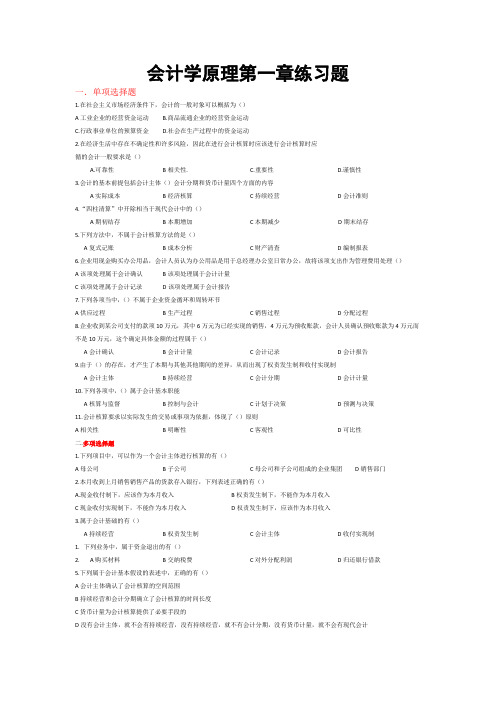
会计学原理第一章练习题一.单项选择题1.在社会主义市场经济条件下,会计的一般对象可以概括为()A工业企业的经营资金运动 B.商品流通企业的经营资金运动C.行政事业单位的预算资金D.社会在生产过程中的资金运动2.在经济生活中存在不确定性和许多风险,因此在进行会计核算时应该进行会计核算时应循的会计一般要求是()A.可靠性B相关性. C.重要性 D.谨慎性3.会计的基本前提包括会计主体()会计分期和货币计量四个方面的内容A实际成本B经济核算C持续经营D会计准则4.“四柱清算”中开除相当于现代会计中的()A期初结存B本期增加C本期减少D期末结存5.下列方法中,不属于会计核算方法的是()A复式记账B成本分析C财产清查D编制报表6.企业用现金购买办公用品,会计人员认为办公用品是用于总经理办公室日常办公,故将该项支出作为管理费用处理()A该项处理属于会计确认B该项处理属于会计计量C该项处理属于会计记录D该项处理属于会计报告7.下列各项当中,()不属于企业资金循环和周转环节A供应过程B生产过程C销售过程D分配过程8.企业收到某公司支付的款项10万元,其中6万元为已经实现的销售,4万元为预收账款,会计人员确认预收账款为4万元而不是10万元,这个确定具体金额的过程属于()A会计确认B会计计量C会计记录D会计报告9.由于()的存在,才产生了本期与其他其他期间的差异,从而出现了权责发生制和收付实现制A会计主体B持续经营C会计分期D会计计量10.下列各项中,()属于会计基本职能A核算与监督B控制与会计C计划于决策D预测与决策11.会计核算要求以实际发生的交易或事项为依据,体现了()原则A相关性B明晰性C客观性D可比性二.多项选择题1.下列项目中,可以作为一个会计主体进行核算的有()A母公司B子公司C母公司和子公司组成的企业集团D销售部门2.本月收到上月销售销售产品的货款存入银行,下列表述正确的有()A.现金收付制下,应该作为本月收入B权责发生制下,不能作为本月收入C现金收付实现制下,不能作为本月收入D权责发生制下,应该作为本月收入3.属于会计基础的有()A持续经营B权责发生制C会计主体D收付实现制1.下列业务中,属于资金退出的有()2.A购买材料B交纳税费C对外分配利润D归还银行借款5.下列属于会计基本假设的表述中,正确的有()A会计主体确认了会计核算的空间范围B持续经营和会计分期确立了会计核算的时间长度C货币计量为会计核算提供了必要手段的D没有会计主体,就不会有持续经营,没有持续经营,就不有会计分期,没有货币计量,就不会有现代会计6.下列各项中,()属于资金投入A本企业收到张三投入的资金10万元B企业向银行借入3年借款50万元C企业发行3年期债券200万元D企业向投资者分配现金股利10万元7.下列有关于会计核算和监督关系的表述中,正确的有()A两者之间关系密切相关,相辅相成,辩证统一B会计核算是会计监督的前提C会计监督是会计可算的保障D会计监督与会计核算没有什么必然的联系8.企业生产经营活动经常包括供应、生产、销售三个阶段,下列各项中,属于供应的过程的有()A建造厂房B购买设备C购买材料D购买生产线9.下列各项中,()属于资金运动过程A资金的投入B资金的循环C资金的周转D资金的退出10.谨慎性原则要求跨级人员在选择会计时()A不高估资产B不低估资产C预计任何可能的收益D确认一切可能发生的损失三.判断题1.会计的基本职能是以货币为计量形式对经济活动进行核算和监督()2.会计期间有时候不等于会计年度()3.为了保持会计信息的可比性,企业一旦选用某种会计处理方法,就不应该改变()4.会计主体和法律主体是同一个概念()5.我国的企业只能以人名币为记账本位币()6.会计核算的及时性是会计信息的生命,是对会计信息质量要求的基本要求()7.从职能属性看,核算和监督本生是一种管理活动,从本质属性来看,会计本生就是一种管理活动()8.签订经济合同是企业开展的经济活动,因此属于会计对象()9.借贷记账法最早产生于我国,目前已经成为世界通用的记账方法()10.我国的《企业会计准则》包括基本准则和具体准则两个层次()四.业务处理题东华股份有限公司9月份发生下列经济业务:(1)销售产品收到现金款项120元(2)销售产品120元,购买单位A交来现款50元,余款暂欠(3)收到购买单位A上月所欠货货款120元(4)收到购买单位B预交货款120元(5)收到C单位交来9~12月仓库租金120元(6)本月已销售产品的生产成本100元(7)本月应交所得税100元,未交(8)本月应交纳上月所欠办公电话费100元(9)本月财产保险费100元,已交50元,余款暂欠(10)支付管理部门10~12月报纸订阅费100元要求:(1)按收付实现制确定东华股份有限公司9月份收入、费用和利润(2)按照权责发生制确定东华股份有限公司9月份收入、费用和利润。
《会计学原理》试题库

第一章 总论一、 单项选择题(每小题1分):1.会计对经济活动的管理,主要是( )。
A.劳动管理B.实物管理C.价值管理D.使用价值的管理2.记账方法在会计史上经历了由单式记账法发展到( )的过程。
A.借贷记账法B.增减记账法C.收付记账法D.复式记账法3.会计的基本职能是( )。
A.反映和考核B.分析和管理C.核算和监督D.预测和决策4.企业投资者对企业净资产的所有权称为( )。
A.权益B.工业产权C.净资产D.所有者权益5.收入、费用和利润是资金运动的( )。
A.存在形态 B.动态表现 C.静态表现 D.形成来源6.作为会计要素的收入,是企业在销售商品或提供劳务等经营业务中实现的( )。
A.营业收入B.投资收益C.全部收入D.营业收入和营业外收入7.( )是会计核算和监督的内容。
A.会计本质B.会计对象C.会计职能D.会计方法8.会计是以( )作为主要计量单位。
A.实物B.劳动C.货币D.实物和货币9.( )是指与产品生产无直接关系,属于经营管理过程中发生的,不计入产品成本,而直接计入当期损益的费用。
A.制造成本B.制造费用C.费用D.期间费用10.会计的产生是由于( )。
A.生产管理的需要B.社会分工的需要C.生产关系变革的需要D.技术进步的需要11.资产、负债和所有者权益是资金运动的( )。
A.存在形态 B.动态表现 C.静态表现 D.形成来源12.我国制订会计准则的主要法律依据是( )。
A.宪法B.国际法C.会计法D.民法13. 新《会计法》实施的时间是( )。
A. 2000年7月1日B. 2000年1月1日C. 1999年12月31日D. 2001年1月1日14.企业计提坏账准备是根据( )。
A.一贯性原则B.真实性原则C.客观性原则D.谨慎性原则15.下列哪项是会计核算的基本前提 ( )。
A. 会计主体B.谨慎性原则C.真实性原则D.客观性原则16. 下列支出属于收益性支出的是:A. 购买固定资产 B. 生产用水电费 C. 生产工人工资 D.短期借款利息17.固定资产加速折旧体现了会计核算中的哪一个一般原则:A .一贯性原则 B.可比性原则 C .真实性原则D .稳健性原则18.下列支出属于资本性支出的是:A. 购买固定资产 B. 生产用水电费 C. 生产工人工资 D.短期借款利息19. 会计期间假设是以下列哪项假设为前提A. 货币计量假设 B. 会计主体假设C. 历史成本假设 D .持续经营假设20.会计核算的( )包括真实性、可靠性和可验证性。
会计学原理习题答案
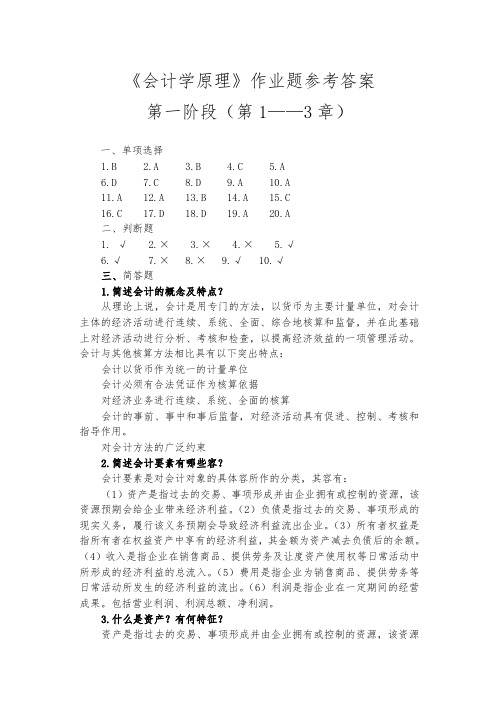
《会计学原理》作业题参考答案第一阶段(第1——3章)一、单项选择1.B2.A3.B4.C5.A6.D7.C8.D9.A 10.A11.A 12.A 13.B 14.A 15.C16.C 17.D 18.D 19.A 20.A二、判断题1. √2.×3.×4.×5.√6.√7.×8.×9.√ 10.√三、简答题1.简述会计的概念及特点?从理论上说,会计是用专门的方法,以货币为主要计量单位,对会计主体的经济活动进行连续、系统、全面、综合地核算和监督,并在此基础上对经济活动进行分析、考核和检查,以提高经济效益的一项管理活动。
会计与其他核算方法相比具有以下突出特点:会计以货币作为统一的计量单位会计必须有合法凭证作为核算依据对经济业务进行连续、系统、全面的核算会计的事前、事中和事后监督,对经济活动具有促进、控制、考核和指导作用。
对会计方法的广泛约束2.简述会计要素有哪些容?会计要素是对会计对象的具体容所作的分类,其容有:(1)资产是指过去的交易、事项形成并由企业拥有或控制的资源,该资源预期会给企业带来经济利益。
(2)负债是指过去的交易、事项形成的现实义务,履行该义务预期会导致经济利益流出企业。
(3)所有者权益是指所有者在权益资产中享有的经济利益,其金额为资产减去负债后的余额。
(4)收入是指企业在销售商品、提供劳务及让度资产使用权等日常活动中所形成的经济利益的总流入。
(5)费用是指企业为销售商品、提供劳务等日常活动所发生的经济利益的流出。
(6)利润是指企业在一定期间的经营成果。
包括营业利润、利润总额、净利润。
3.什么是资产?有何特征?资产是指过去的交易、事项形成并由企业拥有或控制的资源,该资源预期会给企业带来经济利益。
其特征为:第一,资产从本质上讲是一种经济资源。
第二,资产是由过去的交易、事项所形成的。
第三,资产是由企业拥有或控制的。
第四,资产具有有用性。
4.会计核算的方法包括几个方面?会计方法包括七个方面:①设置账户②复式记账③填制和审核凭证④登记账簿⑤成本计算⑥财产清查⑦编制会计报表5.复式记账方法包括哪些基本容?①记账符号。
会计学原理练习题及答案

会计学原理练习题及答案会计学原理练习题及答案第一部分基本概念□理论题△单项选择题1)会计的总体目标是()。
A.进行价值管理B. 提高经济效益C. 提供会计信息D. 控制和指导经济活动2)会计的基本职能是()。
A. 核算与监督B. 分析与考核C. 预测和决策D. 核算与预测3)会计对象是企业再生产过程中的()。
A. 实物运动B. 资产C. 资金运动D. 收入4)会计主体从( )上对会计核算范围进行了有效的界定。
A. 空间B. 时间C. 空间和时间D. 内容5)下列各项中属于划分各会计期间收入和费用的会计处理方法是()A. 一致性原则B. 配比原则C. 谨慎性原则D. 权责发生制原则6)()是指过去的交易或事项形成并由企业拥有或控制的,预期将会给企业带来经济利益的资源。
A. 会计对象B. 资产C. 会计要素D. 资金7)资产、负债和所有者权益三要素是企业资金运动的()。
A. 动态表现B. 静态表现C. 综合表现D. 以上都不对8)我国《企业会计准则》明确规定了()大会计要素。
A. 六B. 八C. 十D. 十二9)反映静态三要素之间关系的会计等式是()。
A.收入-费用=利润B. 资产=负债+权益C. 资产=负债+所有者权益D. 资产+费用=负债+所有者权益10)我国龙门账产生于()。
A.清代B.明末清初C.唐宋时期D.西周时期参考答案:1、B2、A3、C4、A5、D6、B7、B8、A9、C 10、B△多项选择题1)会计可以采用( )计量单位。
A. 货币量度B. 实物量度C. 劳动量度D. 价值指标E.会计计量2)会计的特点包括()。
A. 从价值量上反映B.连续性C.完整性D.系统性E.以会计凭证为依据13)会计核算的基本前提包括 ( )。
A. 会计主体B. 持续经营C. 会计分期D. 货币计量E. 币值稳定4)作为会计要素的收入,包括( )。
A. 主营业务收入B. 营业外收入C.其他业务收入D. 投资收益E. 资本公积5)资产的特点可归纳为( )。
- 1、下载文档前请自行甄别文档内容的完整性,平台不提供额外的编辑、内容补充、找答案等附加服务。
- 2、"仅部分预览"的文档,不可在线预览部分如存在完整性等问题,可反馈申请退款(可完整预览的文档不适用该条件!)。
- 3、如文档侵犯您的权益,请联系客服反馈,我们会尽快为您处理(人工客服工作时间:9:00-18:30)。
1. Accounting is an information system that: A. Identifies business activities. B. Records business activities. C. Communicates business activities. D. Helps people make better decisions. E. All of these.2. Creditors' claims on the assets of a company are called: A. Net losses. B. Expenses. C. Revenues. D. Equity. E. Liabilities.3. The excess of expenses over revenues for a period is: A. Net assets. B. Equity. C. Net loss. D. Net income. E. A liability.4. On June 30 of the current year, the assets and liabilities of Phoenix Phildell are as follows: Cash $20,500; Accounts Receivable, $7,250; Supplies, $650; Equipment, $12,000; Accounts Payable, $9,300. What is the amount of owner's equity as of July1 of the current year? A. $8,300 B. $13,050 C. $20,500D. $31,100 5. Photometer Company paid off $30,000 of its accounts payable in cash. What would be the effects of this transaction on the accounting equation? A. Assets, $30,000 increase; liabilities, no effect; equity, $30,000 increase. B. Assets, $30,000 decrease; liabilities, $30,000 decrease; equity, no effect. C. Assets, $30,000 decrease; liabilities, $30,000 increase; equity, no effect.D. Assets, no effect; liabilities, $30,000 decrease; equity,$30,000 increase.E. Assets, $30,000 decrease; liabilities, no effect; equity $30,000 decrease. 6. The financial statement that reports whether the business earned a profit and also lists the types and amounts of the revenues and expenses is called: A. A Balance Sheet. B. A Statement of Owner's Equity. C. A Statement of Cash Flows. D. An Income Statement. E. A Statement of Financial Position.7. A balance sheet lists: A. The types and amounts of the revenues and expenses of a business. B. Only the information about what happened to equity during a time period. C. The types and amounts of assets, liabilities, and equity of a business as of a specific date.D. The inflows and outflows of cash during the period.E. The assets and liabilities of a company but not the owner's equity. 8. The financial statement that shows the beginning balance of owner's equity; the changes in equity that resulted from new investments by the owner, net income (or net loss); withdrawals; and the ending balance, is the: A. Statement of Financial Position. B. Statement of Cash Flows. C. Balance Sheet. D. Income Statement. E. Statement of Owner's Equity. 9. Accountspayable appear on which of the following statements?A. Balance Sheet.B. Income Statement.C. Statement of Owner's Equity.D. Statement of Cash Flows.E. Transaction Statement. 10. A company's balance sheet shows: cash $22,000, accounts receivable $16,000, office equipment $50,000, and accounts payable $17,000. What is the amount of owner's equity? A. $17,000.B. $29,000.C. $71,000.D. $88,000.E. $105,000. 11. The accounting process begins with: A. Analysis of business transactions and source documents. B. Preparing financial statements and other reports. C. Summarizing the recorded effect of business transactions. D. Presentation of financial information to decision-makers. E. Preparation of the trial balance. 12. The account used to record the transfers of assets from a business to its owner is: A. A revenue account. B. The owner's withdrawals account. C. The owner's capital account. D. An expense account. E. A liability account.13. A written promise to pay a definite sum of money ona specified future date is a(n): A. Unearned revenue. B. Prepaid expense. C. Credit account. D. Note payable. E.Account receivable. 14. A ledger is: A. A record containing increases and decreases in a specific asset, liability, equity, revenue, or expense item. B. A journal in which transactions are first recorded. C. A collection of documents that describe transactions and events entering the accounting process. D. A list of all accounts with their debit balances at a point in time. E. A record containing all accounts and their balances used by a company.15. Double-entry accounting is an accounting system:A. That records each transaction twice.B. That records the effects of transactions and other events in at least two accounts with equal debits and credits.C. In which each transaction affects and is recorded in two or more accounts but that could include two debits and no credits.D. That may only be used if T-accounts are used.E. That insures that errors never occur. 16. Rocky Industries received its telephone bill in the amount of $300, and immediately paid it. Rocky's general journal entry to record this transaction will include a A. Debit to Telephone Expense for $300. B. Credit to Accounts Payable for $300. C. Debit to Cash for $300. D. Credit toTelephone Expense for $300. E. Debit to Accounts Payable for $300. 17. Management Services, Inc. provides services to clients. On May 1, a client prepaid Management Services $60,000 for 6-months services in advance. Management Services' general journal entry to record this transaction will include a A. Debit to Unearned Management Fees for $60,000. B. Credit to Management Fees Earned for $60,000. C. Credit to Cash for $60,000. D. Credit to Unearned Management Fees for $60,000. E. Debit to Management Fees Earned for $60,000. 18. Wisconsin Rentals purchased office supplies on credit. The general journal entry made by Wisconsin Rentals will include a: A. Debit to Accounts Payable. B. Debit to Accounts Receivable. C. Credit to Cash. D. Credit to Accounts Payable. E. Credit to Wisconsin Rentals, Capital. 19. On September 30, the Cash account of Value Company had a normal balance of $5,000. During September, the account was debited for a total of $12,200 and credited for a total of $11,500. What was the balance in the Cash account at the beginning of September? A. A $0 balance. B. A $4,300 debit balance. C. A $4,300 credit balance. D. A $5,700debit balance. E. A $5,700 credit balance.20. The following transactions occurred during July: 1. Received $900 cash for services provided to a customer during July. 2. Received $2,200 cash investment from Barbara Hanson, the owner of the business. 3. Received $750 from a customer in partial payment of his account receivable which arose from sales in June. 4. Provided services to a customer on credit, $375. 5. Borrowed $6,000 from the bank by signing a promissory note. 6. Received $1,250 cash from a customer for services to be rendered next year. What was the amount of revenue for July? A. $ 900. B. $ 1,275. C. $ 2,525. D. $ 3,275. E. $11,100. 21. At the beginning of January of the current year, Thomas Law Center's ledger reflected a normal balance of $52,000 for accounts receivable. During January, the company collected $14,800 from customers on account and provided additional services to customers on account totaling $12,500. Additionally, during January one customer paid Thomas $5,000 for services to be provided in the future. At the end of January, the balance in the accounts receivable account should be: A. $54,700. B. $49,700. C. $2,300. D.$54,300. E. $49,300. 22. During the month of March, Cooley Computer Services made purchases on account totaling $43,500. Also during the month of March, Cooley was paid $8,000 by a customer for services to be provided in the future and paid $36,900 of cash on its accounts payable balance. If the balance in the accounts payable account at the beginning of March was $77,300, what is the balance in accounts payable at the end of March? A. $83,900. B. $91,900. C. $6,600. D. $75,900.E. $4,900. 23. The time period principle assumes that an organization's activities can be divided into specific time periods including: A. Months. B. Quarters. C. Fiscal years. D. Calendar years. E. All of these.24. A broad principle that requires identifying the activities of a business with specific time periods such as months, quarters, or years is the: A. Operating cycle of a business. B. Time period principle. C. Going-concern principle. D. Matching principle. E. Accrual basis of accounting. 25. The accounting principle that requires revenue to be reported when earned is the: A. Matching principle. B. Revenue recognition principle. C. Time period principle. D. Accrual reporting principle. E.Going-concern principle. 26. Adjusting entries: A. Affect only income statement accounts. B. Affect only balance sheet accounts. C. Affect both income statement and balance sheet accounts. D. Affect only cash flow statement accounts. E. Affect only equity accounts. 27. The broad principle that requires expenses to be reported in the same period as the revenues that were earned as a result of the expenses is the: A. Recognition principle. B. Cost principle. C. Cash basis of accounting. D. Matching principle. E. Time period principle. 28. Adjusting entries are journal entries made at the end of an accounting period for the purpose of: A. Updating liability and asset accounts to their proper balances. B. Assigning revenues to the periods in which they are earned. C. Assigning expenses to the periods in which they are incurred. D. Assuring that financial statements reflect the revenues earned and the expenses incurred. E. All of these. 29. The approach to preparing financial statements based on recognizing revenues when they are earned and matching expenses to those revenues is: A. Cash basis accounting. B. The matching principle. C. The timeperiod principle. D. Accrual basis accounting. E. Revenue basis accounting.30. Prepaid expenses, depreciation, accrued expenses, unearned revenues, and accrued revenues are all examples of: A. Items that require contra accounts. B. Items that require adjusting entries. C. Asset and equity.D. Asset accounts.E. Income statement accounts. .31. The accrual basis of accounting: A. Is generally accepted for external reporting because it is more useful than cash basis for most business decisions. B. Is flawed because it gives complete information about cash flows.C. Recognizes revenues when received in cash.D. Recognizes expenses when paid in cash.E. Eliminates the need for adjusting entries at the end of each period 32. A company made no adjusting entry for accrued and unpaid employee wages of $28,000 on December 31. This oversight would: A. Understate net income by $28,000. B. Overstate net income by $28,000. C. Have no effect on net income. D. Overstate assets by $28,000.E. Understate assets by $28,000. 33. If a company mistakenly forgot to record depreciation on office equipment at the end of an accounting period, thefinancial statements prepared at that time would show: A. Assets overstated and equity understated. B. Assets and equity both understated. C. Assets overstated, net income understated, and equity overstated. D. Assets, net income, and equity understated. E. Assets, net income, and equity overstated. 34. If a company failed to make the end-of-period adjustment to remove from the Unearned Management Fees account the amount of management fees that were earned, this omission would cause: A. An overstatement of net income. B. An overstatement of assets. C. An overstatement of liabilities. D. An overstatement of equity. E. An understatement of liabilities.35. Accrued revenues: A. At the end of one accounting period often result in cash receipts from customers in the next period. B. At the end of one accounting period often result in cash payments in the next period. C. Are also called unearned revenues. D. Are listed on the balance sheet as liabilities. E. Are recorded at the end of an accounting period because cash has already been received for revenues earned. 36. An account linked with another account that has an opposite normalbalance and that is subtracted from the balance of the related account is a(n): A. Accrued expense. B. Contra account. C. Accrued revenue. D. Intangible asset. E. Adjunct account. 37. Prior to recording adjusting entries, the Office Supplies account had a $359 debit balance. A physical count of the supplies showed $105 of unused supplies available. The required adjusting entry is: A. Debit Office Supplies $105 and credit Office Supplies Expense $105. B. Debit Office Supplies Expense $105 and credit Office Supplies $105. C. Debit Office Supplies Expense $254 and credit Office Supplies $254. D. Debit Office Supplies $254 and credit Office Supplies Expense $254. E. Debit Office Supplies $105 and credit Supplies Expense $254. 38. On April 1, 2009, a company paid the $1,350 premium on a three-year insurance policy with benefits beginning on that date. What will be the insurance expense on the annual income statement for the year ended December 31, 2009? A. $1,350. B. $450.C. $1,012.50.D. $337.50.E. $37.50. 39. On January 1 a company purchased a five-year insurance policy for $1,800 with coverage starting immediately. If the purchase was recorded in the Prepaid Insurance account,and the company records adjustments only at year-end, the adjusting entry at the end of the first year is: A. Debit Prepaid Insurance, $1,800; credit Cash, $1,800. B. Debit Prepaid Insurance, $1,440; credit Insurance Expense, $1,440. C. Debit Prepaid Insurance, $360; credit Insurance Expense, $360. D. Debit Insurance Expense, $360; credit Prepaid Insurance, $360. E. Debit Insurance Expense, $360; credit Prepaid Insurance, $1,440.40. PPW Co. leased a portion of its store to another company for eight months beginning on October 1, 2009, at a monthly rate of $800. This other company paid the entire $6,400 cash on October 1, which PPW Co. recorded as unearned revenue. The journal entry made by PPW Co. at year- end on December 31, 2009 would include: A. A debit to Rent Earned for $2,400. B.A credit to Unearned Rent for $2,400. C. A debit to Cash for $6,400. D. A credit to Rent Earned for $2,400. E. A debit to Unearned Rent for $4,000. 41. A company pays each of its two office employees each Friday at the rate of $100 per day for a five-day week that begins on Monday. If the monthly accounting period ends onTuesday and the employees worked on both Monday and Tuesday, the month-end adjusting entry to record the salaries earned but unpaid is: A. Debit Unpaid Salaries $600 and credit Salaries Payable $600. B. Debit Salaries Expense $400 and credit Salaries Payable $400.C. Debit Salaries Expense $600 and credit Salaries Payable $600.D. Debit Salaries Payable $400 and credit Salaries Expense $400.E. Debit Salaries Expense $400 and credit Cash $400. 42. The difference between the cost of an asset and the accumulated depreciation for that asset is called A. Depreciation Expense. B. Unearned Depreciation. C. Prepaid Depreciation. D. Depreciation Value. E. Book Value. 43. A company purchased a new truck at a cost of $42,000 on July 1, 2009. The truck is estimated to have a useful life of 6 years and a salvage value of $3,000. The company uses the straight-line method of depreciation. How much depreciation expense will be recorded for the truck for the year ended December 31, 2009? A. $3,250. B. $3,500. C. $4,000. D. $6,500. E. $7,000. 44. If a company records prepayment of expenses in an asset account, the adjusting entry would: A. Result in a debitto an expense and a credit to an asset account. B. Cause an adjustment to prior expense to be overstated and assets to be understated. C. Cause an accrued liability account to exist. D. Result in a debit to a liability and a credit to an asset account. E. Decrease cash.45. If accrued salaries were recorded on December 31 with a credit to Salaries Payable, the entry to record payment of these wages on the following January 5 would include: A. A debit to Cash and a credit to Salaries Payable. B. A debit to Cash and a credit to Prepaid Salaries. C. A debit to Salaries Payable and a credit to Cash. D. A debit to Salaries Payable and a credit to Salaries Expense. E. No entry would be necessary on January 5. 46. A company purchased new computers at a cost of $14,000 on September 30, 2010. The computers are estimated to have a useful life of 4 years and a salvage value of $2,000. The company uses the straight-line method of depreciation. How much depreciation expense will be recorded for the computers for the year ended December 31, 2010? A. $250 B. $750 C. $875 D. $1,000 E. $3,000 47. A trial balance prepared after adjustments have been recordedis called a(n) : A. Balance sheet. B. Adjusted trial balance. C. Unadjusted trial balance. D. Classified balance sheet. E. Unclassified balance sheet. 48. When closing entries are made: A. All ledger accounts are closed to start the new accounting period. B. All temporary accounts are closed but not the permanent accounts. C. All real accounts are closed but not the nominal accounts. D. All permanent accounts are closed but not the nominal accounts. E. All balance sheet accounts are closed. 49. Assets, liabilities, and equity accounts are not closed; these accounts are called: A. Nominal accounts. B. Temporary accounts. C. Permanent accounts. D. Contra accounts. E. Accrued accounts 50. Which of the following is the usual final step in the accounting cycle? A. Journalizing transactions. B. Preparing an adjusted trial balance. C. Preparing a post-closing trial balance. D. Preparing the financial statements. E. Preparing a work sheet.51. A classified balance sheet: A. Measures a company's ability to pay its bills on time. B. Organizes assets and liabilities into important subgroups. C. Presents revenues, expenses, and net income. D.Reports operating, investing, and financing activities. E. Reports the effect of profit and withdrawals on owner's capital. 52. The assets section of a classified balance sheet usually includes: A. Current assets, long-term investments, plant assets, and intangible assets. B. Current assets, long-term assets, revenues, and intangible assets. C. Current assets, long-term investments, plant assets, and equity. D. Current liabilities, long-term investments, plant assets, and intangible assets. E. Current assets, liabilities, plant assets, and intangible assets. 53. Two common subgroups for liabilities on a classified balance sheet are: A. current liabilities and intangible liabilities. B. present liabilities and operating liabilities. C. general liabilities and specific liabilities. D. intangible liabilities and long-term liabilities. E. current liabilities and long-term liabilities. 54. The special account used only in the closing process to temporarily hold the amounts of revenues and expenses before the net difference is added to (or subtracted from) the owner's capital account is the: A. Income Summary account. B. Closing account. C. Balance column account. D. Contra account.E. Nominal account. 55. The following information is available for the Travis Travel Agency. After these closing entries what will be the balance in the Jay Travis, Capital account? A. $ 65,000. B. $ 80,000. C. $130,000. D. $145,000. E. $280,000.。
